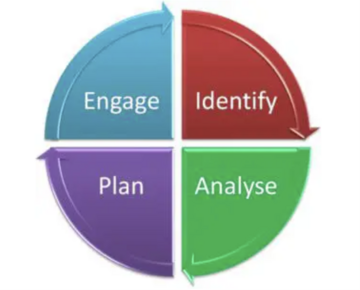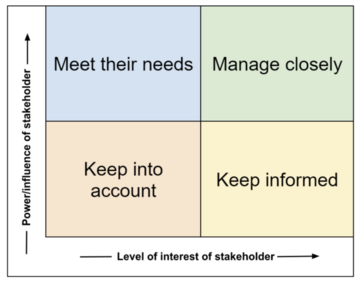Stakeholder mapping
(→Application) |
|||
| Line 48: | Line 48: | ||
'''Identification:''' identify the project's stakeholders, for example by creating a brainstorm. This tool is verry useful because a project can have many stakeholders and they can be both internal or external. Write down all persons or groups that will be affected in some way of the project. Don’t think too much about it you can always delete some stakeholders from the list afterwards, the worst that can happen is to forget some stakeholders. | '''Identification:''' identify the project's stakeholders, for example by creating a brainstorm. This tool is verry useful because a project can have many stakeholders and they can be both internal or external. Write down all persons or groups that will be affected in some way of the project. Don’t think too much about it you can always delete some stakeholders from the list afterwards, the worst that can happen is to forget some stakeholders. | ||
| − | '''Categorization:''' With the list of all stakeholders you must now categorize the stakeholders into four different groups. Each of the four quadrants in the matrix indicates the difference in how to handle the stakeholders. <ref> https://simplystakeholders.com/stakeholder-mapping/ ref> Take one stakeholder at the time and decide their influence on the project and their level of interest in the project. | + | |
| + | '''Categorization:''' With the list of all stakeholders you must now categorize the stakeholders into four different groups. Each of the four quadrants in the matrix indicates the difference in how to handle the stakeholders. <ref> https://simplystakeholders.com/stakeholder-mapping/ </ref> Take one stakeholder at the time and decide their influence on the project and their level of interest in the project. | ||
| + | |||
| + | [[File:Model_2.png|thumb|upright=2.0|alt=Overview of the Stage-Gate Process, with an emphasis on gate decisions.|'''Figure 2: '''Visualization of decisions at the gates of the Stage-Gate Process]] | ||
| + | |||
| + | |||
| + | '''High power / high interest –''' Stakeholders in this quadrant are the most important once for the project. They must be managed closely, regularly engage, and you have to manage their expectations. | ||
| + | |||
| + | '''High power / low interest –''' Stakeholders in this quadrant are very powerful but not verry interested in the project. Therefore, its important to meet their needs, keep them satisfied, and actively consult them. | ||
| + | |||
| + | '''Low power / low interest –''' Stakeholders in this quadrant don’t have much influence on the project. However, it’s important to monitor and provide information to them as needed. | ||
| + | |||
| + | '''Low power / high interest –''' Stakeholders in this quadrant do not have much influence but they have a high interest in the project. Therefor keep them informed and maintain their interest during the project. | ||
| + | |||
=Limitation= | =Limitation= | ||
Revision as of 15:27, 19 February 2023
Contents |
Abstract
This article is about the importance of making a stakeholder mapping before making changes in a working group for example in a company. The stakeholders can have influence or be able to affect the project. The influence or affect can occur before, under and after the execution of the project, and the stakeholders can have positive or negative influence on the project. Therefor it’s important that you handle the stakeholders in the right way when starting a project.
In this article you will be given the right tools for making a good Stakeholder Mapping. The Stakeholder Map consist of 4 steps: Identification, Categorization, Strategy for handling and Communication plan. [1]
The article will include following:
• What is Stakeholder mapping
• Whom are the Stakeholders
• The Idea behind the Method
• How to analyze
- Identification
- Categorization
- Strategy for handling
- Communication plan
After having read this article, the reader should be ready to make a Stakeholder Analysis specific to the project they are working on.
Big idea
Stakeholder mapping is a tool that helps you with identifying all stakeholders in any types of projects. It is important to make the stakeholder analysis in order to make sure you handle all the stakeholders in the right way. In all types of projects there will typically be many different stakeholders which means many different expectations to the outcome of the project.[2] Therefor it’s important to make a plan for how to communicate with all of the stakeholders in order to make them collaborate in the project. When making a stakeholder analysis you will start out by identifying all the current stakeholders in relation to the project. When all stakeholders are found, you have to categorize them in a matrix in order to their level of influence and level of interest.
When the stakeholders are categorized you have to make a plan for how to handle the stakeholders. This plan will include pros and cons, their affect on the project (positive or negative) and how to handle them. When you know how to handle the stakeholders its time to make a communication plan. This plan shall make it clear how to communicate with the stakeholders, when to communicate and whom are responsible for the communication. Stakeholder mapping is a dynamic tool because stakeholders will sometimes chance during a project. Therefor you will have to reconsider the stakeholder analysis during your project. Figure 1 shows the cycle of stakeholder mapping, and it will first stop when the project has ended.
Model_1.png Model_2.png
Application
How to do the stakeholder mapping?
Identification: identify the project's stakeholders, for example by creating a brainstorm. This tool is verry useful because a project can have many stakeholders and they can be both internal or external. Write down all persons or groups that will be affected in some way of the project. Don’t think too much about it you can always delete some stakeholders from the list afterwards, the worst that can happen is to forget some stakeholders.
Categorization: With the list of all stakeholders you must now categorize the stakeholders into four different groups. Each of the four quadrants in the matrix indicates the difference in how to handle the stakeholders. [3] Take one stakeholder at the time and decide their influence on the project and their level of interest in the project.
High power / high interest – Stakeholders in this quadrant are the most important once for the project. They must be managed closely, regularly engage, and you have to manage their expectations.
High power / low interest – Stakeholders in this quadrant are very powerful but not verry interested in the project. Therefore, its important to meet their needs, keep them satisfied, and actively consult them.
Low power / low interest – Stakeholders in this quadrant don’t have much influence on the project. However, it’s important to monitor and provide information to them as needed.
Low power / high interest – Stakeholders in this quadrant do not have much influence but they have a high interest in the project. Therefor keep them informed and maintain their interest during the project.

